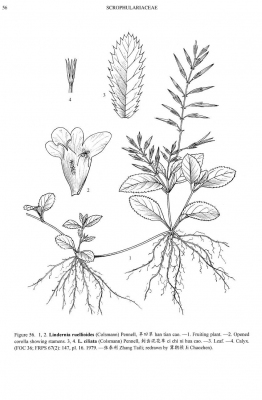Lindernia ruellioides
(Colsm.) Pennell
Linderniaceae
A recent study in the family Linderniaceae - Fischer E.; Schäferhoff B. & Müller K.: The Phylogeny of Linderniaceae - The New Genus Linderniella, and new combinations within Bonnaya, Craterostigma, Lindernia, Micranthemum, Torenia and Vandellia. Willdenowia 43: 209 - 238. December 2013. ISSN 0511-9618 - has proposed moving several genera from Scrophulariaceae into Lindernia; resurrecting the genera Bonnaya and Vandellia from within Lindernia; and describes a new genus Linderniella. These changes have not yet been accepted - if they do then this species will become Bonnaya ruellioides (Colsm.) Spreng.
Bonnaya reptans (Roxb.) Spreng.
Bonnaya ruellioides (Colsm.) Spreng.
Gratiola reptans Roxb.
Gratiola ruelloides Colsm.
Ilysanthes ruellioides (Colsm.) Kuntze
Lindernia reptans (Roxb.) F. Muell.
Common Name:
General Information
Lindernia ruellioides is an annual plant growing 10 - 15cm tall with stolons up to 30cm long. The stems are usually branched, rarely erect, rooting at the lower nodes[
266- Title
- Flora of China
- Publication
-
- Author
-
- Website
- http://flora.huh.harvard.edu/china/
- Publisher
- Missouri Botanical Garden Press; St. Louis.
- Year
- 1994
- ISBN
-
- Description
- An excellent, comprehensive resource in 25 volumes. In addition to the botanical information the flora also gives basic information on habitat and some uses. An on-line version is also available.
].
The plant is harvested from the wild for local use as a medicine.
No threats have been reported for this species. The plant is classified as 'Least Concern' in the IUCN Red List of Threatened Species(2013)[
338- Title
- IUCN Red List of Threatened Species
- Publication
-
- Author
-
- Website
- http://www.iucnredlist.org/
- Publisher
-
- Year
- 0
- ISBN
-
- Description
- A list of plants under threat and facing possible extinction, usually with brief details of the threats and information on habitat.
].
Known Hazards
None known
Botanical References
266- Title
- Flora of China
- Publication
-
- Author
-
- Website
- http://flora.huh.harvard.edu/china/
- Publisher
- Missouri Botanical Garden Press; St. Louis.
- Year
- 1994
- ISBN
-
- Description
- An excellent, comprehensive resource in 25 volumes. In addition to the botanical information the flora also gives basic information on habitat and some uses. An on-line version is also available.
Range
E. Asia - China, southern Japan, India, Myanmar, Cambodia, Vietnam, Malaysia, Indonesia, Philippines to New Guinea
Habitat
Grassland, plains, mountain valleys, forests; at elevations below 1,500 metres[
266- Title
- Flora of China
- Publication
-
- Author
-
- Website
- http://flora.huh.harvard.edu/china/
- Publisher
- Missouri Botanical Garden Press; St. Louis.
- Year
- 1994
- ISBN
-
- Description
- An excellent, comprehensive resource in 25 volumes. In addition to the botanical information the flora also gives basic information on habitat and some uses. An on-line version is also available.
].
Properties
| Conservation Status | Least Concern |
| Medicinal Rating |      |
| Habit | Annual |
| Height | 0.12 m |
| Cultivation Status | Wild |
Cultivation Details
Not known
Edible Uses
None known
Medicinal
The leaves are useful in the treatment of wounds, bruises, boils, jaundice, snakebite, dysentery, urinary troubles and for promoting the quick healing of wounds[
338- Title
- IUCN Red List of Threatened Species
- Publication
-
- Author
-
- Website
- http://www.iucnredlist.org/
- Publisher
-
- Year
- 0
- ISBN
-
- Description
- A list of plants under threat and facing possible extinction, usually with brief details of the threats and information on habitat.
].
The whole plant is applied topically to treat worms in the skin[
240- Title
- Glossary of Indian Medicinal Plants (Including the Supplement).
- Publication
-
- Author
- Chopra. R. N., Nayar. S. L. and Chopra. I. C.
- Publisher
- Council of Scientific and Industrial Research, New Delhi.
- Year
- 1986
- ISBN
- -
- Description
- Very terse details of medicinal uses of plants with a wide range of references and details of research into the plants chemistry. Not for the casual reader.
].
We have no more specific information, but most Lindernia species are very bitter and many are used medicinally to treat conditions such as dysentery and other intestinal problems, and as a tonic after childbirth. Applied externally, they are widely used in poultices for relieving boils, sores and itches etc[
K- Title
- Plants for a Future
- Author
- Ken Fern
- Description
- Notes from observations, tasting etc at Plants For A Future and on field trips.
].
Other Uses
None known
Propagation
Seed -
If you have any useful information about this plant, please leave a comment. Comments have to be approved before they are shown here.


 Useful Tropical Plants Database 2014 by
Ken Fern,
web interface by
Ajna Fern
with help from
Richard Morris.
Useful Tropical Plants Database 2014 by
Ken Fern,
web interface by
Ajna Fern
with help from
Richard Morris.